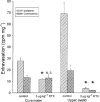Capsaicin-insensitive sensory-efferent meningeal vasodilatation evoked by electrical stimulation of trigeminal nerve fibres in the rat
- PMID: 10385246
- PMCID: PMC1566033
- DOI: 10.1038/sj.bjp.0702561
Capsaicin-insensitive sensory-efferent meningeal vasodilatation evoked by electrical stimulation of trigeminal nerve fibres in the rat
Abstract
1. Antidromic vasodilatation and plasma extravasation to stimulation of the trigeminal ganglion or its perivascular meningeal fibres was investigated by laser-Doppler flowmetry and 125I-labelled bovin serum albumin in the dura mater and in exteroceptive areas (nasal mucosa, upper eyelid) of anaesthetized rats pretreated with guanethidine and pipecuronium. 2 Trigeminal stimulation at 5 Hz for 20 s elicited unilateral phasic vasodilatation in the dura and lasting response in the nasal mucosa. Resiniferatoxin (1-3 microg kg(-1) i.v.), topical (1%) or systemic capsaicin pretreatment (300 mg kg(-1) s.c. plus 1 mg kg(-1) i.v.) did not inhibit the meningeal responses but abolished or strongly inhibited the nasal responses. Administration of vinpocetine (3 mg kg(-1) i.v.) increased both basal blood flow and the dural vasodilatation to perivascular nerve stimulation. 3. Dural vasodilatation to trigeminal stimulation was not inhibited by the calcitonin gene-related peptide-1 receptor (CGRP-1) antagonist hCGRP8-37 (15 or 50 microg kg(-1) i.v), or the neurokinin-1 receptor antagonist RP 67580 (0.1 mg kg(-1) i.v.) although both antagonists inhibited the nasal response. Neither mucosal nor meningeal responses were inhibited by atropine (5 mg kg(-1) i.v.), hexamethonium (10 mg kg(-1) i.v.) or the vasoactive intestinal polypeptide (VIP) antagonist (p-chloro-D-Phe6-Leul7)VIP (20 microg kg(-1) i.v.). 4. Plasma extravasation in the dura and upper eyelid elicited by electrical stimulation of the trigeminal ganglion was almost completely abolished in rats pretreated with resiniferatoxin (3 microg kg(-1) i.v.). 5. It is concluded that in the rat meningeal vasodilatation evoked by stimulation of trigeminal fibres is mediated by capsaicin-insensitive primary afferents, while plasma extravasation in the dura and upper eyelid and the vasodilatation in the nasal mucosa are mediated by capsaicin-sensitive trigeminal fibres.
Figures









Similar articles
-
Capsaicin-sensitive neurogenic sensory vasodilatation in the dura mater of the rat.J Physiol. 2003 Nov 1;552(Pt 3):859-67. doi: 10.1113/jphysiol.2003.050633. Epub 2003 Aug 29. J Physiol. 2003. PMID: 12949222 Free PMC article.
-
Involvement of capsaicin-sensitive afferent nerves in the proteinase-activated receptor 2-mediated vasodilatation in the rat dura mater.Neuroscience. 2009 Jul 7;161(3):887-94. doi: 10.1016/j.neuroscience.2009.04.010. Epub 2009 Apr 8. Neuroscience. 2009. PMID: 19362118
-
Vanilloid type 1 receptors (VR1) on trigeminal sensory nerve fibres play a minor role in neurogenic dural vasodilatation, and are involved in capsaicin-induced dural dilation.Br J Pharmacol. 2003 Oct;140(4):718-24. doi: 10.1038/sj.bjp.0705486. Br J Pharmacol. 2003. PMID: 14534154 Free PMC article.
-
Sensory and motor reflex control of nasal mucosal blood flow and secretion; clinical implications in non-allergic nasal hyperreactivity.Acta Physiol Scand Suppl. 1991;600:1-64. Acta Physiol Scand Suppl. 1991. PMID: 1891972 Review.
-
Neurogenic inflammation in the context of migraine.Microsc Res Tech. 2001 May 1;53(3):167-78. doi: 10.1002/jemt.1081. Microsc Res Tech. 2001. PMID: 11301492 Review.
Cited by
-
Capsaicin-sensitive neurogenic sensory vasodilatation in the dura mater of the rat.J Physiol. 2003 Nov 1;552(Pt 3):859-67. doi: 10.1113/jphysiol.2003.050633. Epub 2003 Aug 29. J Physiol. 2003. PMID: 12949222 Free PMC article.
-
Capsaicin-induced vasodilatation in human nasal vasculature is mediated by modulation of cyclooxygenase-2 activity and abrogated by sulprostone.Naunyn Schmiedebergs Arch Pharmacol. 2011 Jun;383(6):613-26. doi: 10.1007/s00210-011-0638-6. Epub 2011 Apr 28. Naunyn Schmiedebergs Arch Pharmacol. 2011. PMID: 21523557
-
A PEPTIDE UNCOUPLING CRMP-2 FROM THE PRESYNAPTIC Ca(2+) CHANNEL COMPLEX DEMONSTRATES EFFICACY IN ANIMAL MODELS OF MIGRAINE AND AIDS THERAPY-INDUCED NEUROPATHY.Transl Neurosci. 2012 Mar;3(1):1-8. doi: 10.2478/s13380-012-0002-4. Transl Neurosci. 2012. PMID: 22662308 Free PMC article.
References
-
- CARMODY J., PAWLAK M., MESSLINGER K. Lack of role for substance P in the control of dural arterial flow. Exp. Brain Res. 1996;111:424–428. - PubMed
-
- ESCOTT K.J., BEATTIE D.T., CONNOR H.E., BRAIN S.D. Trigeminal ganglion stimulation increases facial skin blood flow in the rat: a major role for calcitonin gene-related peptide. Brain Res. 1995a;669:93–99. - PubMed
-
- ESCOTT K.J., CONNOR H.E., BRAIN S.D., BEATTIE D.T. The involvement of calcitonin gene-related peptide (CGRP) and substance P in feline pial artery diameter responses evoked by capsaicin. Neuropeptides. 1995b;29:129–135. - PubMed
-
- FUSCO B.M., FIORE G., GALLO F., MARTELLETTI P., GIACOVAZZO M. Capsaicin-sensitive sensory neurons in cluster headache: pathophysiological aspects and therapeutic indication. Headache. 1994;34:132–137. - PubMed
Publication types
MeSH terms
Substances
LinkOut - more resources
Full Text Sources
Other Literature Sources
Research Materials

